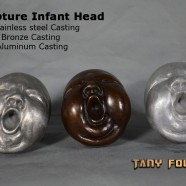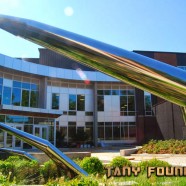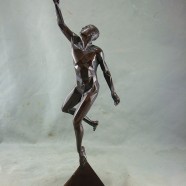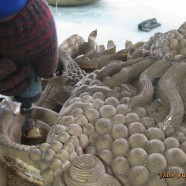Tips of Choosing Metal Alloy For Sculptures
Knowing the options and difference between metal alloys is the foundation to create beautiful sculptures. The most three commonly used metal alloy in fine art foundry is bronze, aluminum and stainless steel, which features different mechanical property and application. In this post, we’d like to introduce the major difference, as well as the upsides and downsides of each option so you can make achieve the ideal artistic appearance for your sculpture project at minimal cost possible. Here are photos of sculptures named “infant heads” which are cast with these three alloys. The left is stainless steel casting. It looks silver like after proper surface treatment and finishing. The middle is bronze casting. It looks more “traditional” . The right is aluminum casting. Aluminum casting is more and more employed nowadays to replace bronze for a couple of reasons. Below is the takeaway for this post. Bronze Casting Aluminum Casting Stainless steel Casting Bronze casting is the most widely used traditional alloy. Highly flexible for patina, finishing and texture treatment. Bronze can be used for both miniature and monument with different casting technique: lost wax casting and sand casting. The cost of bronze casting lies between of casting aluminum and stainless steel. One of best upside of bronze is it can cast sculpture with the finest details and texture. Aluminum casting is becoming more and more popular for a couple of reason: 1) It is cheaper than bronze casting. 2) It is highly corrosion resistance. 3) It is lighter than bronze and aluminum, which make installation easier, especially monumental sculpture. Downside of aluminum casting: 1) Its weldability is poor. Only very skillful welder can do it well. 2) The hardness of aluminum is not as high as bronze, making its strength not as solid as bronze too. Stainless steel can be used for casting small sized sculptures. Its hardness and corrosion resistance performance is superior. The downsides of stainless steel casting is that 1) It costs more than bronze and aluminum. 2) Usually it is only used for small sized sculpture as the chasing and finishing on stainless steel is very difficult. 3) It is very heavy. We suggest to take the following factors into consideration when choosing the specific alloy for your sculpture project. Budget: Stainless steel casting costs most and aluminum cost less and bronze lies in the middle. Artistic Appearance: In most cases, the color of a piece of work is determined beforehand so the alloy has to match that color. Scale of the project: bronze can be used from miniature; aluminum is more often used in middle or large sized works while stainless steel is for small sized works. Feel free to let me know if you need any technical assistance for your own sculpture project by sending us an...
Read MoreCreate Mirror Polished Stainless steel Sculpture from Drawing
Mirror polished stainless steel is commonly used in modern public art because of its stunning finishing and beautiful artistic appearance. However, it is also well known that it is not easy to fabricate perfect mirror polished works. In this post, we’d like to introduce the technique and workflow Tany Foundry employs to create art fabrication works. This sculpture is called Fluid Movement. They are four pieces swimming arm like stainless steel sculptures. The size of one art is 12 feet long x 3.5 feet height. Here is a brief description on how we made it. Step 1: Digital Modeling. The commonly used digital model applications are Zbrush, 3DMax,Rhino, etc. Step 2: Engineering and Preping stainless steel sheet. High quality stainless steel is the foundation to create beautiful works. We use the marine grade stainless steel sheet 316, which features superior corrosion resistance performance and high strength. It is crucial to make sure that the stainless steel sculptures will never get corrosion placed outdoors, even in warm and high humidity environment. Compared with stainless steel Grade 201 and 304, stainless steel 316 works much more better on build quality. Stainless steel sheet. The armature and the base of the sculptures is 16 MM thick,which is extremely strong for the structure. It can even stands a couple adults climbing on the sculpture. Cutting and bending the stainless steel sheeting according to design.We use high precision water jet cutter or plasma cutter to cut stainless steel sheet into the shape we wanted. Step 3: Building Armature of the sculpture. All joints are full welded to maximize strength. We use TIG and MIG for welding. The welding rods have to be exactly the same as the stainless steel sheet. Otherwise there will be imperfection on the finished works. Step 4: Fabrication This is the crucial steps in the entire fabrication process. Only experienced fabricators are assigned in this stage. The sculptures will be formed as its design. All the welding joints and seams have to fulled examined. We double check the angle of the sculpture to make sure it is correct. In theory, the measure should be correct as long as the armature is right. However, it is import to double check the measurement during fabrication process. This can guarantee the precision of the final work. We lift the sculpture to examine its overall look. It looks fine. Step 5: Polishing Polishing is a dirty job, involving many steps, which have to be performed in correct order and in right technique. These are material commonly used for polishing: polishing wheel, cotton wheel, non-woven wheel and polishing paste. The hard and tough polishing wheel is used in first stage and then softer cotton wheel. Polishgin paste of different colors are also used in different stage. Step 6: Shipping and Installation Feel free to let me know if you have any technical question on how to fabricate stainless steel sculptures or you need a quote for your own project. Click the link below or call...
Read MoreTrending of Combination of Sculpture and Internet
Nowadays technology, especially the smartphone and internet, has been radically reshaping every aspect on our life. Of course sculpture is not an exception. I have a few random thoughts on how the smart phone and mobile internet can possibly change the way viewers interact with the sculpture and its artist. ( the sculpture above is by renowned artist Anish Kapoor ) In the future, every public art will have its own 2D barcode. Viewers can use their phone to scan the barcode and it leads them to a web page, allowing them to Browse more background info on this piece of work: why and how it is made, The page can even play some video clips on the manufacturing process. The page even allows viewers to interact with the artist in a living way. I can imagine it is not difficult to connect with the barcode with an instant messager like Skype or Google Talk. The viewers can chat with artist, ask questions and get answered, etc. The artist’s bio, his/her career path, other works, his own statement of this work. You can see, at this stage, the relation between artwork, viewers and artists has changed. It is more interactive; it deepens viewer’s understanding about the work and the artist. The viewers get more involved with public art. On the other hand, with some statistic data, artist can even know how many people view his work, like or dislike the work. Honest feedback is possible now. I can expect the trending will be around corner. What do you think ? I expect your comments. ...
Read MoreBronze sculpture: The process from 3D printing to Bronze casting
As a leading art foundries in China, we explores combing new tech with traditional bronze casting technique. Below is a bronze sculpture we cast for artist Ken Sealey.The sculpture is 50 cm tall. The artist sends us digital model of the sculpture. We use 3D printing tech to print it out first and then make rubber mold and cast bronze. Below is a short documentation on how we make it. Step 1 : Digital modeling Step 2 : 3D Printing Step 3: Molding & Bronze casting Step 4: Finishing & Patina Feel free to email us if you have any question or you need a quote for your own project. Or just click the button to call us FREE. [skype-status skype_id=”tanyfoundry” user_name=”Tany Foundry...
Read MoreArt Foundry Field book for Sculptor Series
Knowing the capacity and limit of foundry tools is important for sculptors who want to create a piece of successful art work. Even with the best design and intention, it can realize within the capacity of foundry tool. I am planning to write a series posts on the common tools art foundry use for casting bronze/ aluminum sculptures, which may be useful for sculptors who want to know how to use proper tool to achieve the ideas artistic effect he/she wants. This time I’d like to a tool: air scribe, which plays an important role in finishing bronze casting or aluminum casting. As we know, many sculptures features very nice details and texture. However, it is never easy to achieve that without careful chasing and finishing work. Air Scribe is one of the useful helpers we use to do that. Below is a video clip on how we use the scribe. Here are a few features you can employ from air scribe It rotates rapidly and powerfully to make the bronze casting smoother. The scribe can replaced with tools with different hardness and diameter, fit for different purpose. It is suitable for using after bronze chasing to refine some details and texture on bronze casting. We recommend choosing the proper size scribe according to the bronze sculpture you are working on. You have to be very careful when handling small pieces with high level of textured details. A smaller diameter scribe works best on those pieces. Starts from slower speed and make it faster when necessary. We are using an air scribe to do finishing on a piece of bronze cast sculpture. ( Silicon Bronze) It works quite well on the finishing job. The detail is becoming clear and smooth. Feel free to let me know if you have any question....
Read More




